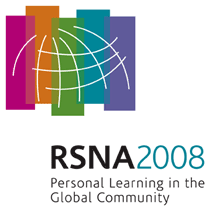
Abstract Archives of the RSNA, 2008
Troy LaBounty, Presenter: Nothing to Disclose
Baskaran Sundaram MBBS, Abstract Co-Author: Research grant, Bayer AG
Elina Yamada, Abstract Co-Author: Nothing to Disclose
Prachi Agarwal MD, Abstract Co-Author: Nothing to Disclose
William Armstrong MD, Abstract Co-Author: Nothing to Disclose
Ella A. Kazerooni MD, Abstract Co-Author: Consultant, General Electric Company
Consultant, Vital Images, Inc
Research funded, General Electric Company
Aortic valve calcification (AVC) on echocardiography predicts adverse events in aortic stenosis (AS), although the implications of AVC on computed tomography (CT) are not established.
Event-free survival (valve replacement or death) was evaluated in 72 consecutive patients who underwent both ECG-gated 64-detector CT and transesophageal echocardiography (TEE) for AS assessment. Readers blindly and independently graded AVC and AS severity respectively on CT and TEE. Significant AVC (dense calcifications in all leaflets) on CT was compared to low AVC, with further stratification by severe (valve area < 1cm2) or non-severe AS on TEE. Kaplan-Meier curves with log-rank tests and Cox regression analysis were performed.
Significant AVC on CT was present in 45/72 patients. AS on TEE was mild in 22, moderate in 8, and severe in 42 patients. Events occurred in 58 patients (death = 3, valve replacement = 55); mean time to event was 1.9 ± 2.0 months. Mean follow-up in the remaining was 10.0 ± 7.4 months. Patients with significant AVC had lower event-free survival at 6 months than those with low AVC (8.0% versus 46.1%, p<0.001). With Cox regression analysis, significant AVC (hazard ratio = 3.3, p < 0.001) on CT and severe AS (hazard ratio = 2.7, p=0.001) on TEE are independently associated with adverse events.
Significant AVC on CT is associated with lower event-free survival in patients with AS, independent of AS severity. AVC should be reported on ECG-gated CT of the heart and thoracic aorta.
Significant aortic valve calcification on computed tomography is associated with increased adverse events.
LaBounty, T,
Sundaram, B,
Yamada, E,
Agarwal, P,
Armstrong, W,
Kazerooni, E,
Aortic Valve Calcification on Computed Tomography Is Associated with Adverse Events. Radiological Society of North America 2008 Scientific Assembly and Annual Meeting, February 18 - February 20, 2008 ,Chicago IL.
http://archive.rsna.org/2008/6011809.html

